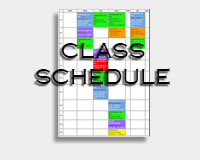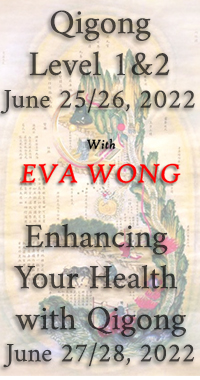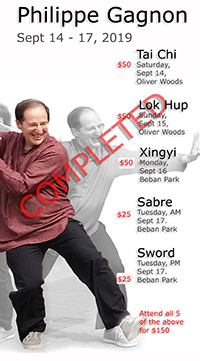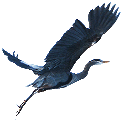
AGENDA
| TAI CHI | |||
| Saturday, Sept 10 | 09:00 to 09:30 | Check in | Oliver Woods Community Ctre, Nanaimo. |
| 09:30 to 12:30 | Tai Chi | Oliver Woods Community Ctre, Nanaimo. | |
| 12:30 to 14:00 | Lunch | ||
| 14:00 to 17:00 | Tai Chi | Oliver Woods Community Ctre, Nanaimo. | |
| 19:00 to 20:30 | Tai Chi | ||
| LOK HUP | |||
| Sunday, Sept 11 | 09:30 to 10:00 | Check in | Oliver Woods Community Ctre, Nanaimo. |
| 10:00 to 12:30 | Lok Hup | Oliver Woods Community Ctre, Nanaimo. | |
| 12:30 to 14:00 | Lunch | ||
| 14:00 to 17:00 | Lok Hup | Oliver Woods Community Ctre, Nanaimo. | |
| SWORD | |||
| Monday, Sept 12 | 09:30 to 10:00 | Check in | Bradley Centre, Coombs BC. |
| 10:00 to 12:30 | Sword | Bradley Centre, Coombs BC. | |
| 12:30 to 14:00 | Lunch | ||
| 14:00 to 17:00 | Sword | Bradley Centre, Coombs BC. | |
| SABRE | |||
| Tuesday, Sept 13 | 09:30 to 10:00 | Check in | Bradley Centre, Coombs BC. |
| 10:00 to 12:30 | Sabre | Bradley Centre, Coombs BC. | |
| 12:30 to 14:00 | Lunch | ||
| 14:00 to 17:00 | Sabre | Bradley Centre, Coombs BC. | |
| TAI CHI Hosted by Parksville Tai Chi | |||
| Wednesday, Sept 14 | 09:30 to 10:00 | Check in | Bradley Centre, Coombs BC. |
| 10:00 to 12:30 | Tai Chi | Bradley Centre, Coombs BC. | |
| 12:30 to 14:00 | Lunch | ||
| 14:00 to 17:00 | Tai Chi | Bradley Centre, Coombs BC. | |
Download a printable schedule HERE.
SEPTEMBER 2016 WORKSHOP REGISTRATION
Following is a list of the workshops available with pricing.
| TAI CHI NANAIMO WORKSHOPS (Nanaimo ONLY phone:250-756-0070) | COST | |
| A | Tai Chi: September 10, 2016, Oliver Woods Community Centre, Nanaimo | $50 |
| B | Lok Hup: September 11, 2016, Oliver Woods Community Centre, Nanaimo | $50 |
| C | Sword: September 12, 2016, Bradley Centre, Coombs. | $50 |
| D | Sabre: September 13, 2016, Bradley Centre, Coombs. | $50 |
| PARKSVILLE TAI CHI WORKSHOP (Parksville Tai Chi ONLY Ph: 250-757-2097) | COST | |
| E | Tai Chi, September 14, 2016, Bradley Centre, Coombs. | $50 |
About LOK HUP
Huayue Xinyi Liuhebafa quan is the full name of the form commonly known as “lokhup”, which I studied under master Moy Lin-Shin (and more briefly from master Sun Dit) between 1975 and 1998. It means literally the “fist (form) of the six harmonies and eight methods of the heart [mind] (and) intention of the Hua mountain summit.
Legend
The mention of Mount Hua, traditionally regarded as one of the five sacred mountains of China, is a reference to Chen Tuan (also kown as Chen Xiyi), a hermit who lived there one thousand years ago, and to whom the creation of this form, or at least its fundamental inspiration, has been attributed. Just like for taijiquan, a contemporary tradition attributes the creation of the art to a prestigious founder in remote times, leaving unexplained a historical gap lasting several centuries. The claim contain several messages – that this art is thoroughly indigenous, that it is based on Daoist philosophy and transformative practices, and that it is distinct from taijiquan, and even more ancient (and therefore constitutes a senior art). Of course, none of this can be verified, but it’s not really the point.
Transmission
Wu Yihui (1887-1958) is the first historical figure to have taught lokhup openly, starting from the 1930’s in Shanghai and Nanjing. He apparently had three teachers who belonged to the same school (HuaYue Xiyi men), but what they taught and where their skills originated from is unknown. One of Wu Yihui’s students was Liang Zipeng, and through him the art reached masters Sun Dit and Moy Lin-shin. Master Moy used lokhup as an important “building block” in his transformation of traditional Yang style taijiquan, making the study of lokhup an essential part of our curriculum, to better understand this unique taijiquan form.
Six harmonies and eight methods
Overall, very little has been written about the principles of Lokhup, if we compare the art to taijiquan. Wu Yihui and a few others published indications regarding the “six harmonies” and “eight methods”. The six harmonies refer to “internal” (energy) and “external” (muscle, bone, joints) harmony. The word “harmony” is used in English, but in Chinese, the word “he” means joining, uniting, as well as harmonizing. The standard explanation goes like this: The body harmonizes (or unites) with the heart(mind), the heart with intention, intention with qi, qi with shen [spirit], spirit with movement, movement with kong [emptiness].
I have heard several other sets of 6 harmonies, linking various pairs or trios of joints. Master Moy also proposed his own set of 6 harmonies: The internal harmony between jing, qi, shen (generative, vital and spiritual energy) and external harmony (eyes, ears and throat/mouth/nose system).
More can be (and has been) said about all this, but which ever way these sets of “harmonies” are explained, they only evoke (rather than describe) a trained ability to move made possible by a particular focusing of the mind. My experience is that the notion of six harmonies provides a general sense of movement and analytical framework, helpful to guide and measure our progress, but what this means in practice can only be really understood through regular training.
The eight methods are listed as qi (energy), gu (bone), xing (form), sui (following), ti (rising), huan (returning), le (restraining), fu (lying in wait). While the last five refer to movement principles, the first three refer to training focus: inner circulation, bone structure, proper alignment of postures.
Philippe Gagnon
January 14, 2014
About Philippe Gagnon
Philippe Gagnon – ‘taijiquan’ biography – October 2012
Philippe was introduced to the internal arts* of Master Moy Lin-shin in Montreal at the age of 18. He trained under Master Moy (and with many of his prominent students) from 1975 until 1998, when Master Moy passed away. In the earlier years, Philippe also explored different training methods, receiving instruction from respected Wu and Yang style taijiquan masters in Canada and Taiwan. Between 1976 and 1983, Philippe taught extensively in Montreal, but also travelled regularly to other cities to help create training centers in Quebec. He was also initiated to the syncretic teachings (Confucian, Buddhist and Daoist) and meditation practices of the Fung Loy Kok temple, co-founded in Hong Kong (Tsuen Wan) by Daoist priest Mui Ming-To and his wife Tang Yuen-Mei, with whom Master Moy shared spiritual roots. From 1983 to 1989, Philippe lived in China (Wuhan, Hong Kong), a period that provided a rich experience of encounters with masters and practitioners of several styles. Philippe continued to train with Master Moy during their reciprocal travels to Canada and Hong Kong, but Master Moy also introduced him to one of his original teachers, Master Sun Di (Sun Zhi), himself a prominent student of Master Liang Zipeng, in particular to learn the second half of the Lok Hup (Xinyi Liuhebafa) sequence and experience some of the pushing-hands for which Master Sun was famous. During that period, Philippe taught local classes and also regularly attended at the Fung Loy Kok temple in Tsuen Wan.
Philippe returned to Montreal at the end of ’89 and served as a prominent instructor and legal advisor at Master Moy’s original school, teaching across Canada and also coordinating the national merger of numerous local groups into a single organisation. He also served several years as president of the Canadian Fung Loy Kok institute of Taoism, which he helped to restructure under Master Moy’s guidance. In the 1990s, he accompanied Master Moy at international workshops in the US and in Europe, both as instructor and organisational advisor for local groups. At the request of Master Moy, he also conceived and implemented the transnational legal and intellectual property structures that would enable the school to grow internationally. He was often trusted as international ‘troubleshooter’, handling delicate situations involving training quality, internal conflicts, organisational growth issues as well as legal matters. After Master Moy’s death in 1998, Philippe continued to work nationally and internationally for several years as an advisor and instructor, until he left the organisation in 2008. Since then, Philippe has conducted an in-depth exploration of Master Moy’s legacy, working with many people who had studied closely with him, but also exploring mindfulness-based spiritual traditions, researching the theory and historical development of taijiquan and consulting with scholars while travelling extensively in Asia and Europe. Philippe wishes to help carry forward the contributions of Master Moy, with particular emphasis on the health gymnastic and spiritual dimensions of taijiquan.
Philippe graduated from McGill University’s department of East Asian Studies and Law faculty, and holds a Masters degree in law from the University of Wuhan in China. He has pursued a career as legal advisor to companies and non-profit organisations alike. Father of three children and happily remarried to Italian scholar Chiara Letizia (Professor of South Asian religions), he has now resettled in Montreal.
* taijiquan, taiji sword, taiji sabre, Xinyi liuhebafa, xingyiquan, neigong, etc.





